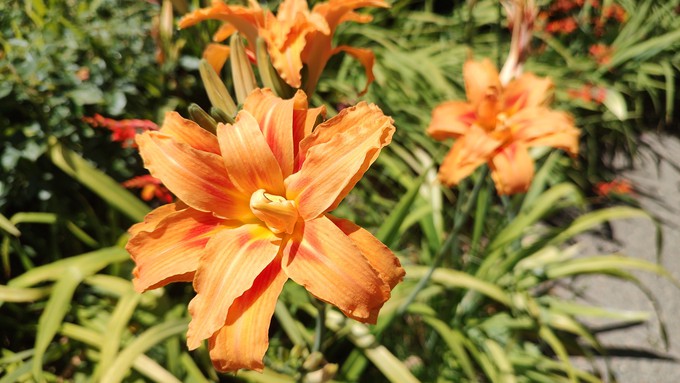
Vegetables and flowers benefit from cooler than average temperatures

A double orange daylily blooms on the first day of summer in Sacramento. Mild June weather may extend bloom season for many late spring favorites. Debbie Arrington
Our (relative) cool streak continues, and that’s good news for our tomatoes and squash.
Summer officially started at 7:57 a.m. Wednesday and, according to the National Weather Service, our new season starts like the last one ended – with below-average temperatures.
“Happy Summer Solstice!” tweeted the NWS Sacramento office on Wednesday morning. “We’re feeling cool for the Summer with these high temperatures. Our highs start to warm slightly as we head into the weekend but our temps will still be below average!”
The forecast calls for Sacramento highs of only 78 degrees on Thursday and 79 on Friday – 10 degrees below our late-June average. We’re expected to warm up slightly to 82 degrees on Saturday and Sunday and can expect more low 80s heading into next week.
So far, June’s daytime highs are averaging four degrees below normal – 82.6 compared to 86.7, says the weather service. That comes after a coolish May with daytime highs averaging three degrees below normal (77.2 compared to 80.3).
While daytime temperatures remain on the cool side, we’re staying relatively warm after dark with overnight lows in the mid 50s. June’s average lows are barely below normal, averaging 55.2 degrees (compared to our historic average of 55.9). That helps soil retain its warmth and keeps summer vegetables growing fast.
Coupled with these mild days, this is ideal weather for rapid development in the vegetable garden. Light breezes should help pollinate tomatoes. Bees and other pollinators love this weather, too; setting new squash and melons shouldn’t be a problem either.
The key will be water. No rain is anywhere in our forecast, so irrigate these fast-growing veggies deeply at least once or twice a week.
Also benefiting from cooler weather: Spring and early summer flowers. Expect our bloom season to continue with big flourishes of roses and lilies.
On the minus side, lots of insects love these mild but warm temperatures. Watch out for explosions of aphids, whiteflies and spider mites.
Also enjoying these days in the 70s: Powdery mildew. Snip off and dispose of infected foliage.
This cool streak is unlikely to last – this is summer in Sacramento. The last June without at least one triple-digit day: 1998.
Our current weather pattern is similar to 2009, notes forecasters. That June also started out with below-average temperatures, but got hot in a hurry; Sacramento hit 108 degrees on June 28 that year.
Long-range predictions for July 2023 say Sacramento will be typically hot and maybe a notch above normal. Forecasters expect the month to average highs of 94 degrees; normal is 92.
For more on Sacramento forecasts: https://www.weather.gov/sto/.
Comments
0 comments have been posted.Sacramento Digs Gardening to your inbox.
Food in My Back Yard Series
May 6: Maintain soil moisture with mulch for garden success
April 29: What's (already) wrong with my tomato plants?
April 22: Should you stock up on fertilizer? (Yes!)
April 15: Grow culinary herbs in containers
April 8: When to plant summer vegetables
April 1: Don't be fooled by these garden myths
March 25: Fertilizer tips: How to 'feed' your vegetables for healthy growth
March 18: Time to give vegetable seedlings some more space
March 11: Ways to win the fight against weeds
March 4: Potatoes from the garden
Feb. 25: Plant a fruit tree now -- for later
Feb. 18: How to squeeze more food into less space
Feb. 11: When to plant? Consider staggering your transplants
Feb. 4: Starting in seed starting
Sites We Like
Garden Checklist for week of May 4
Enjoy this spring weather – and get gardening!
* Plant, plant, plant! It’s prime planting season in the Sacramento area. Time to set out those tomato transplants along with peppers and eggplants. Pinch off any flowers on new transplants to make them concentrate on establishing roots instead of setting premature fruit.
* Direct-seed melons, cucumbers, summer squash, corn, radishes, pumpkins and annual herbs such as basil.
* Harvest cabbage, lettuce, peas and green onions.
* In the flower garden, direct-seed sunflowers, cosmos, salvia, zinnias, marigolds, celosia and asters. (You also can transplant seedlings for many of the same flowers.)
* Plant dahlia tubers. Other perennials to set out include verbena, coreopsis, coneflower and astilbe.
* Transplant petunias, marigolds and perennial flowers such as astilbe, columbine, coneflowers, coreopsis, dahlias, rudbeckia and verbena.
* Keep an eye out for slugs, snails, earwigs and aphids that want to dine on tender new growth.
* Feed summer bloomers with a balanced fertilizer.
* For continued bloom, cut off spent flowers on roses as well as other flowering plants.
* Add mulch to the garden to maintain moisture. Mulch also cuts down on weeds. But don’t let it mound around the stems or trunks of trees or shrubs. Leave about a 6-inch to 1-foot circle to avoid crown rot or other problems.